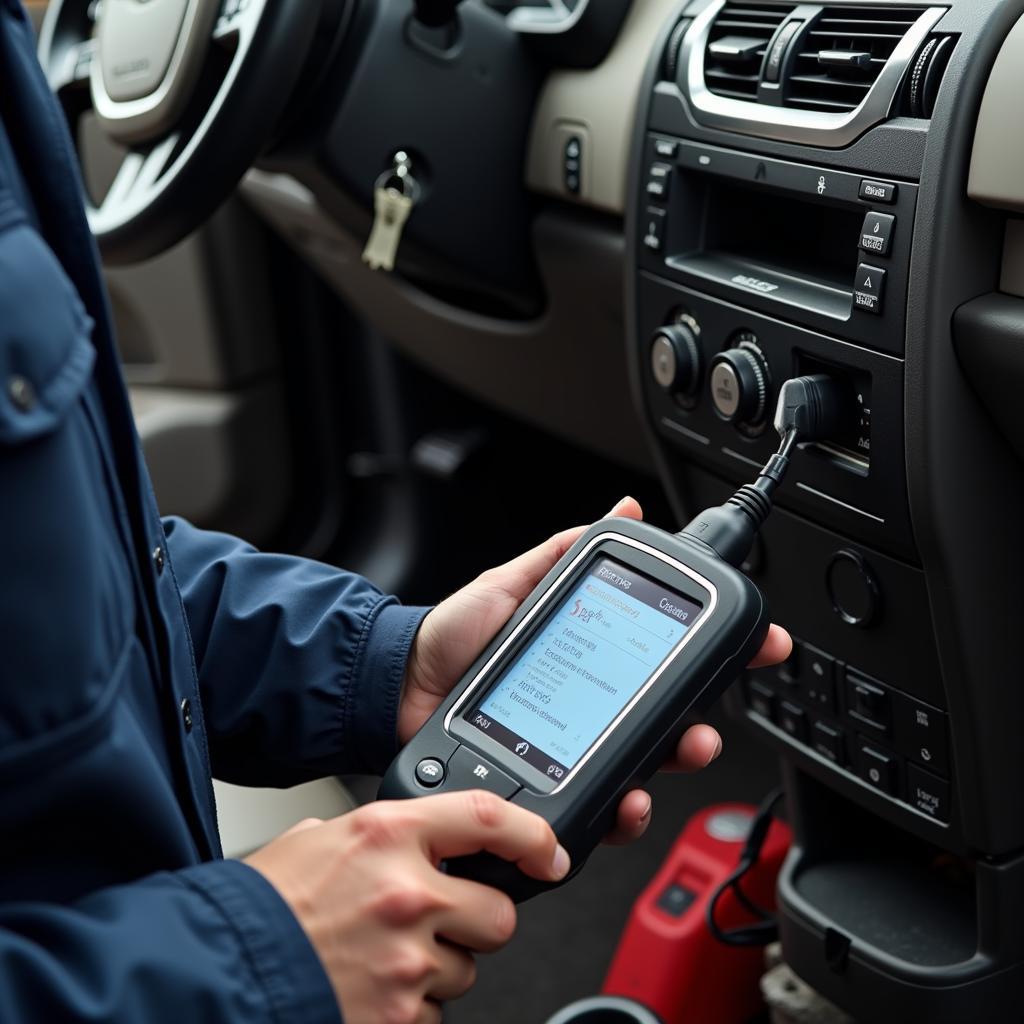The brake pad warning light on your Land Rover Discovery 3 is a crucial safety feature, designed to alert you when the brake pads have worn down and require replacement. Ignoring this warning can lead to reduced braking efficiency and potentially dangerous driving conditions. This comprehensive guide will delve into the common causes of the brake pad warning light illumination and provide you with effective solutions to address this issue.
Understanding the Brake Pad Warning Light System
The brake pad warning light system in your Discovery 3 relies on a simple yet effective mechanism. Embedded within the brake pads are wear sensors, small metal tabs that protrude slightly from the pad material. As the brake pads wear down over time, these sensors eventually come into contact with the brake rotor when applying the brakes.
 Land Rover Discovery 3 Brake Pad Wear Sensor
Land Rover Discovery 3 Brake Pad Wear Sensor
This contact completes an electrical circuit, triggering the brake pad warning light on your dashboard. This visual cue serves as a clear indication that your brake pads require immediate attention.
Common Causes of the Brake Pad Warning Light
While worn brake pads are the most common culprit behind the illuminated warning light, several other factors can also contribute to this issue. These include:
- Worn Brake Pad Sensors: Sometimes, the brake pad sensors themselves can become damaged or worn out prematurely. This can trigger the warning light even if the brake pads themselves still have sufficient material remaining.
- Faulty Brake Fluid Level Sensor: The brake pad warning light can also be linked to the brake fluid level sensor. If this sensor malfunctions and incorrectly detects low brake fluid, it can illuminate the warning light.
- Electrical Issues: Like any electrical system, the brake warning light system can experience wiring issues, loose connections, or a faulty warning light bulb. These electrical gremlins can cause the light to illuminate erratically or remain lit even when no actual brake pad issue exists.
Troubleshooting the Brake Pad Warning Light
Before assuming the worst, it’s essential to rule out any simple explanations for the illuminated warning light. Here are some preliminary checks you can perform:
- Inspect Brake Pad Thickness: Visually inspect your brake pads through the wheel spokes. If you can see less than 1/4 inch of brake pad material remaining, it’s time for a replacement.
- Check Brake Fluid Level: Open the hood and locate the brake fluid reservoir. Ensure the brake fluid level is between the minimum and maximum marks. If the fluid level is low, top it up with the recommended brake fluid for your Discovery 3.
Seeking Professional Assistance
If your preliminary checks don’t reveal any obvious issues, it’s crucial to seek professional assistance from a qualified mechanic or Land Rover specialist. They possess the expertise, diagnostic tools, and experience to pinpoint the exact cause of the warning light and implement the appropriate solutions.
 Diagnosing Brake System Issues on Land Rover Discovery 3
Diagnosing Brake System Issues on Land Rover Discovery 3
“It’s always best to err on the side of caution when it comes to brake systems,” advises John Smith, a seasoned Land Rover mechanic with over 20 years of experience. “Ignoring warning signs can lead to more extensive and costly repairs down the line.”
Importance of Timely Brake Pad Replacement
Timely brake pad replacement is paramount for maintaining optimal braking performance and ensuring your safety on the road. Driving with worn brake pads not only compromises stopping distance but can also damage other brake components, leading to more expensive repairs.
Here’s why you shouldn’t delay brake pad replacement:
- Reduced Braking Efficiency: As brake pads wear thin, their ability to generate friction against the brake rotor diminishes, significantly reducing braking power.
- Increased Stopping Distance: Worn brake pads increase the distance required to bring your vehicle to a complete stop, potentially creating hazardous situations, especially in emergency braking scenarios.
- Damage to Brake Rotors: Driving with severely worn brake pads can cause metal-on-metal contact between the brake pad backing plate and the rotor. This can lead to rotor warping, scoring, or even cracking, necessitating costly rotor replacement.
Preventive Maintenance for Optimal Brake System Health
To extend the lifespan of your brake pads and ensure optimal brake system health, consider these preventive maintenance tips:
- Smooth Braking Habits: Avoid harsh braking whenever possible. Gradual braking puts less strain on the brake pads and promotes even wear.
- Regular Brake Inspections: Schedule routine brake inspections with a qualified mechanic. They can assess the condition of your brake pads, rotors, and other brake components, identifying potential issues before they escalate.
- Quality Brake Pads: When it’s time for brake pad replacement, invest in high-quality brake pads specifically designed for your Land Rover Discovery 3.
Conclusion
The brake pad warning light on your Land Rover Discovery 3 is a critical safety feature that should never be ignored. Understanding the potential causes of this warning light and addressing them promptly is essential for maintaining optimal braking performance and ensuring your safety on the road. By heeding this warning, practicing proactive maintenance, and seeking professional assistance when needed, you can keep your Discovery 3 braking system in peak condition for miles to come.
Frequently Asked Questions
Q: How much does it cost to replace brake pads on a Land Rover Discovery 3?
A: The cost of brake pad replacement can vary depending on factors such as labor rates, the type of brake pads used, and whether additional brake components require replacement. On average, you can expect to pay between $200 and $500 for brake pad replacement on a Discovery 3.
Q: Can I drive with the brake pad warning light on?
A: While you might be able to drive for a short distance with the brake pad warning light on, it’s strongly discouraged. Continuing to drive with worn brake pads will only exacerbate the issue, potentially leading to more extensive and costly damage to your brake system.
Q: How often should I replace my brake pads?
A: Brake pad lifespan can vary greatly depending on driving conditions, braking habits, and brake pad quality. However, it’s generally recommended to have your brake pads inspected every 10,000 to 12,000 miles and replaced as needed.
Q: What happens if I ignore the brake pad warning light for too long?
A: Ignoring the brake pad warning light for an extended period can lead to severe consequences, including significantly reduced braking efficiency, damage to brake rotors, and an increased risk of brake failure, potentially leading to accidents.
Q: Can I replace my brake pads myself?
A: While replacing brake pads is possible as a DIY project, it’s generally recommended to have this task performed by a qualified mechanic. Brake systems are critical safety components, and improper installation can have serious consequences.

